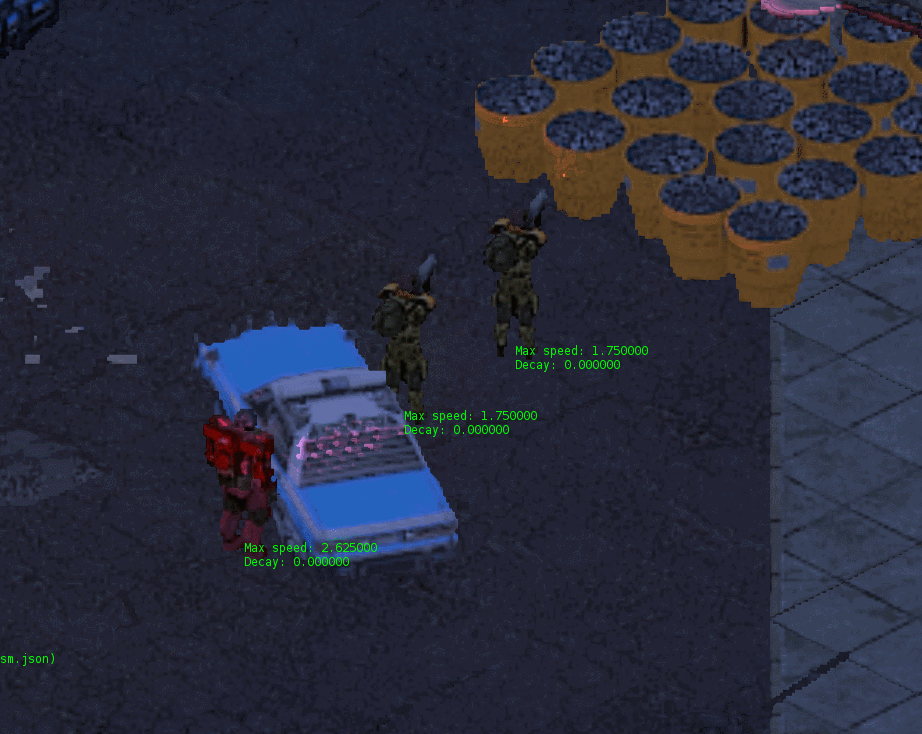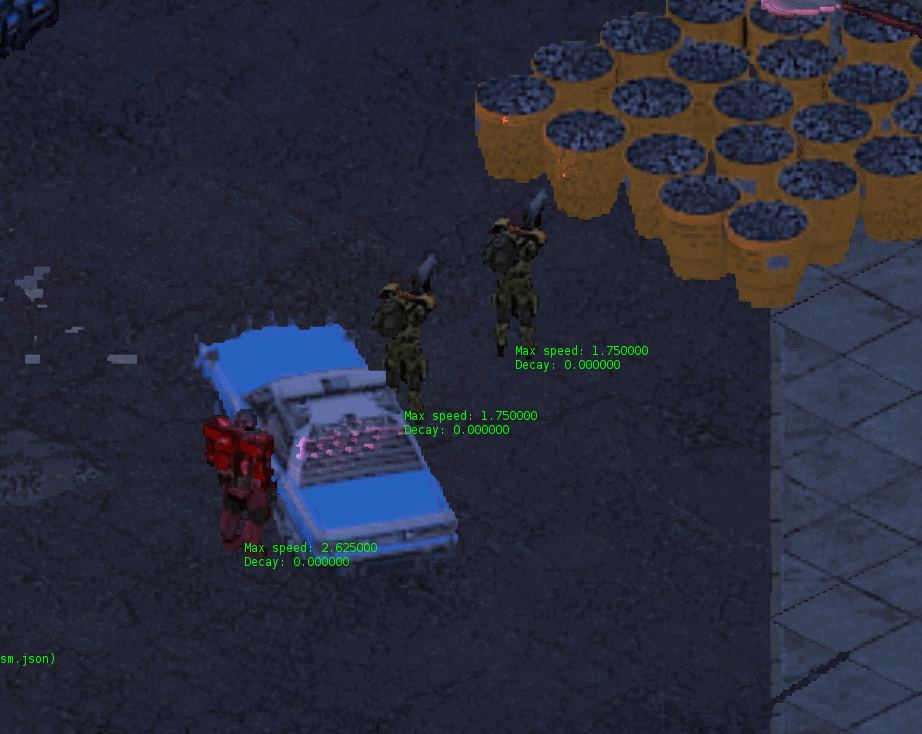WHAT’S IN A GIF?
This month’s post looks like a GIF explainer but it’s secretly a ruse to explain how systems can overlap in Brigador Killers. Here’s the GIF in question, taken from a recent debug build:

We’ve slowed this GIF down considerably because at “normal” speed, it would look something like this…

Also we’ll post the first GIF a bunch of times throughout this article so you’re not constantly scrolling up and down.
The first GIF shows several entities in the short clip. An entity is an object that interacts with the game and responds to player input or other entities. These entities are:
- 1 x Carmine suit
- 1 x police cruiser
- 2 x Dave
- 1 x destructible object or “prop” in the form of yellow buckets filled with water
The Carmine suit is player-controlled. The police cruiser has no driver and is empty. The two Daves are non-player characters that either have no AI or are set to not to react to player actions. The yellow bucket props are in-universe impact attenuators.

We also have some debug visualizations on screen, which are:
- A label called Max speed
- A label called Decay
- Green HP bars above the police cruiser and the two Daves
- A red and orange ring that briefly appears beneath the Carmine suit
Max speed and Decay aren’t important to this specific scene, but we’ll try to explain them regardless. Max speed is, as the name suggests, that unit’s maximum speed. The Carmine suit has a greater motive power than the two Daves. Decay is the “bleed off” of bonus velocity that an entity would get from boosting or charging. In the previous game Brigador, after you stop boosting your vehicle, your max speed immediately goes back down to its original value. We smooth this transition out now for Brigador Killers, but because of how these bonuses work, we have to keep track of how much "bonus" there is which we then gradually subtract from. So, the decay value represents the remaining bonus we're still subtracting from - but the decay value in the GIF is zero because no entities have boosted or charged.
The green HP bars are an abstraction of how many hit points that entity has left after taking damage. A green bar that has turned completely transparent will disappear because the remaining HP has hit zero. Not all entities on screen have HP bars visible. Player-controlled entities like the Carmine suit have their HP displayed elsewhere. Props do not tend to display HP bars either, sometimes because their HP pools are so small and because we express damage to props in other ways. The red and orange ring underneath the Carmine suit are visualizations of the damage radii of the “kick”. You might remember something similar from a previous post about systemic building collapse.
Third, let’s go over the visual effects going on in this GIF.

The visual effects that we can see are:
- A kicking up of dust from the Carmine suit’s “kick”
- A darkening effect on the Carmine suit, police cruiser, two Daves and prop
- The Daves changing animation states
- The inertia of the police cruiser after colliding with the prop
Technically the Carmine suit’s “kick” here is actually a reused mech stomp. More specifically, it’s not a stomp at all, but an explosion. This is also the reason why the suit briefly darkens.
The darkening effect is to visualize to the player that an entity has taken damage in some way. As a result, every entity that appears in the GIF takes damage in some manner, including the prop.
The two Daves change animation states because they have entered what’s called a pain state (sometimes referred to as “flinching”), with both being pushed aside by the hitbox of the police cruiser. One of the Daves that’s still visible dies as they fall over backwards, losing the HP bar in the process.
The car’s inertia after impacting the prop carries it forward a small distance more before eventually rolling to a stop. Now for the fun and penultimate part - here’s what’s going on in terms of behind-the-scenes systems.

Some of these systems are holdovers from our first game, some of them are new to Brigador Killers. In action in this GIF are:
- Impulse
- Wheeled vehicles
- Trample
- Reverse trample
Impulse is how the police cruiser gains velocity and is pushed sideways into the Daves. The impulse comes from the explosive “stomp” kick of the Carmine suit.
Due to Brigador Killers’ new wheeled vehicles implementation, cars can better act like four-wheeled vehicles. We spoofed wheeled vehicle movement in Brigador for vehicles like the Pantry Boy treadbike or the Varlet tuk tuk by taking the tank movement and making the treads very “narrow” to give the sense of a bike/trike-style movement. Currently in BK, wheeled vehicles don’t have the handbrake on, meaning they can be pushed around easily just from NPCs bumping into them. The Carmine suit’s kick delivers more than enough impulse to send the cruiser sideways into the Daves.
Trample is a means of causing damage that already exists in Brigador - it’s how mechs are able to stomp through buildings like with the Touro or ramming through enemy vehicles with your Killdozer.
Reverse trample is different. Reverse trample is a system new to Brigador Killers in which trample damage can be self-inflicted. A simple way to think of it is how you can get hurt because you went very fast into something solid. However, in BK, reverse trample can kick in from both rapid deceleration and rapid acceleration.
So finally with all of the above in mind, here’s the detailed play-by-play of the GIF:

- The player in the Carmine suit hits the police cruiser with an explosive “kick” that gives the car impulse.
- The police cruiser immediately takes damage from the kick and the impulse sends it in a direction away from the source of the impulse.
- Almost instantly the first Dave takes reverse trample damage due to the rapid acceleration it inherits from the police cruiser. The police cruiser may also be inflicting a small amount of trample damage on the Dave.
- A frame later the second Dave takes damage for the same reasons as the first (reverse trample and trample).
- The police cruiser continues towards the yellow impact attenuator prop, inflicting trample damage on it.
- The Dave on the right exits off screen and survives, but the Dave on the left, after rapidly accelerating and taking both damage from reverse trample and trample, takes a second bout of reverse trample damage because it catches the corner of the prop and rapidly decelerates. This makes the total interaction lethal to the Dave on the left.
- Leftmost Dave’s HP is fully reduced, its death animation plays out, and the NPC flops backwards onto the ground.
- The police cruiser still has inertia and continues to roll forwards before stopping.
All of what you just read is about 1000 words explaining what happens in roughly a second of gameplay.

Why we bothered to write that all out is because at the time of capturing this GIF we didn’t even expect the second Dave to have been killed by the interaction - we would have been content enough with the police cruiser shunting into the NPCs and inflicting some reverse trample damage, which it did.
Instead, we’ve found ourselves in a much more exciting place, because we now know that such player actions have the potential to be “messy” in ways that means players won’t see the exact same thing over and over if they replay certain combat scenarios. The reason this has happened is because it’s a combination of multiple overlapping systems that, in some cases, have taken several years to develop, and can now be expressed in Brigador Killers.

If you enjoyed this post, you can find quite a few more in-development GIFs on our discord server’s #brigador_killers_chat channel

Get Brigador Killers
Brigador Killers
Isometric power fantasy
| Status | In development |
| Author | Stellar Jockeys |
| Genre | Action, Shooter |
| Tags | Cyberpunk, Dystopian, Isometric, Mechs, Music, Retro, Sci-fi, Singleplayer, Top-Down |
More posts
- BRIGADOR KILLERS: THE COMBAT BUILD16 days ago
- Beauty renders in the inventory screen26 days ago
- A Quick Look At The Latest Brigador Killers Build58 days ago
- Updating our plans for June87 days ago
- Your Reactions To Pilgrim Two Weeks OnMar 28, 2025
- Brigador Killers: Pilgrim Is HereMar 11, 2025
- Our Plans For The First Half Of 2025Feb 27, 2025
- Ghost LightsJan 30, 2025
- Meet the Teddy BoyDec 20, 2024
- Crash Test Dummies In Brigador KillersNov 28, 2024
Comments
Log in with itch.io to leave a comment.
Freakin' awesome!